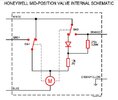I remember my granddaughter being born some 18 years ago now, and a desperate phone call from my daughter, the central heating is not working.
It was a Y Plan, and armed with my meters, I went to fix it. Very quickly worked out boiler not being switched on, at time a new build, but they must have used monkeys, as only twin and earth to thermostat, and earth used for the hysteresis improver resistance. So my problem was to know what readings to expect from the motorised valve, now I have a circuit diagram,

back then I had little idea what was inside the device, both my daughter and I short of money, and it was a leap of faith to go to
Screwfix and buy a motorised valve, as it seemed likely the problem, but readings were inconclusive. And not helped by incorrect info, asked daughter did the radiators get warm in summer, she answered no.
Anyway it transpired, before they bought the house, the heating must have failed, and to get it going, someone latched the bleed lever open, the son-in-law tidying up before the daughter arrived home with the new baby, had knocked the lever unlatching it, this resulted in the original fault returning. And the new motorised valve cured the problem, and I let out a sigh of relief.
The point is, even with my test equipment it was a bit of trial and error, I was 80% sure I had found the problem, but those resistors and diode in the valve were giving me some odd readings when I did not know what was inside.
Today, the first test would be to latch the valve and see if the heating starts to work. Not a cure, but it is a pointer to what the problem is, we must assume the plumber is not an idiot, so looking for a fault he could easily miss. And a latched valve, where someone has done it to hide the fault, is easy to miss.


